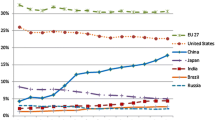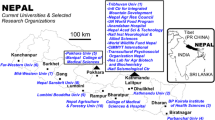Abstract
Bioinformatics is an emerging and rapidly evolving discipline. The bioinformatics literature is growing exponentially. This paper aims to provide an integrated bibliometric study of the knowledge base of Chinese research community, based on the bibliometric information in the field of bioinformatics from SCI-Expanded database during the period of 2000–2005. It is found that China is productive in bioinformatics as far as publication activity in international journals is concerned. For comparative purpose, the results are benchmarked against the findings from five other major nations in the field of bioinformatics: USA, UK, Germany, Japan and India. In terms of collaboration profile, the findings imply that the collaborative scope of China has gradually transcended boundaries of organizations, regions and nations as well. Finally, further analyses on the citation share and some surrogate scientometric indicators show that the publications of Chinese authors suffer from a lowest international visibility among the six countries. Strikingly, Japan has achieved most remarkable impact of publication when compared to research effort devoted to bioinformatics amongst the six countries. The policy implication of the findings lies in that Chinese scientific community needs much work on improving the research impact and pays more attention to strengthening the academic linkages between China and worldwide nations, particularly scientifically advanced countries.
Similar content being viewed by others
References
Ajiferuke, I., Burrell, Q., Tague, J. (1988), Collaborative coefficient: A single measure of the degree of collaboration in research, Scientometrics, 14: 421–433.
Ball, P. (2005), Index aims for fair ranking of scientists, Nature, 436: 900.
Bornmann, L., Daniel, H.-D. (2005), Does the h-index for ranking of scientists really work? Scientometrics, 65: 391–392.
Braun, T., Glänzel, W., Schubert, A. (2006), A Hirsch-type index for journals, Scientometrics, 69: 169–173.
Buela-casal, G., Perakakis, P., Taylor, T., Checa, P. (2006), Measuring internationality: Reflections and perspectives on academic journals, Scientomertics, 67(1): 45–65.
Burrell, Q. L. (2005), Measuring similarity of concentration between different informetric distribution: Two new approaches, Journal of the American Society for Information Science and Technology, 56(7): 704–714.
Cole, S., Cole, J. R. (1967), Scientific output and recognition, American Sociological Review, 32: 377–390.
Cole, S., Cole, J. R. (1968), Visibility and the structural bases of awareness of scientific research., American Sociological Review, 33: 397–413.
Frame, J. D. (1977), Mainstream research in Latin America and Caribbean, Interciencia, 2: 143–148.
Garg, K. C., Padhi, P. (2001), A study of collaboration in laser science and technology, Scientometrics, 50(2): 415–427.
Garg, K. C., Padhi, P. (2002), Scientometrics of laser research in India during 1970–1994, Scientometrics, 55(2): 215–241.
Garg, K. C. (2002), Scientometrics of laser research in India and China, Scientometrics, 55(1): 71–85.
Glänzel, W. (2000), Science in Scandinavia: A bibliometric approach, Scientometrics, 48: 121–150.
Glänzel, W., Schubert, A. (2001), Double effort = double impact? A critical view at international coauthorship in chemistry, Scientometrics, 50: 199–214.
Gordon, M. D. (1980), A critical reassessment of inferred relations between multiple authorship, scientific collaboration, the production of papers and their acceptance for publication, Scientometrics, 2(3): 193–201.
Guan, J. C., Ma, N. (2004), A comparative study of research performance in computer science, Scientometrics, 61(3): 339–359.
Guan, J. C., He, Y. (2005), Comparison and evaluation of domestic and international outputs in information science & technology research of China, Scientometrics, 65(2): 215–244.
Hirsch, J. E. (2005), An index to quantify an individual’s scientific research output, Proceedings of the National Academy of Sciences of the United States of America, 102: 16569–16572.
King, D. A. (2004) The scientific impact of nations, Nature, 430: 313–316.
Kostoff, R. N. (2002), Citation analysis of research performer quality, Scientometrics, 53(1): 49–71.
Lancaster, F. W. (1986), Vocabulary Control for Information Retrieval, 2nd ed. Arlington, VA.: Information Resources.
Ma, N., Guan, J. C. (2005), An exploratory study on collaboration profiles of Chinese publications in Molecular Biology, Scientometrics, 65(3): 343–355.
Moed, H. F. (2000), Bibliometric indicators reflect publication and management strategies, Scientometrics, 47: 323–346.
Moed, H. F. (2002), Measuring China’s research performance using the Science Citation Index, Scientometrics, 53(3): 281–296.
Popov, S. B. (2005), A parameter to quantify dynamics of a researcher’s scientific activity. arXiv:physics/0508113.
Price, D. De. S. (1963), Little Science, Big Science. Columbia University Press, New York.
Price, D. De. S. (1981), The analysis of scientometric metrics for policy implications, Scientometrics, 3: 47–54.
Patra, S. K., Mishra, S. (2006), Bibliometric study of bioinformatics literature, Scientometrics, 67(3): 477–489.
Schubert, A., Braun, T. (1986), Relative indicators and relational charts for comparative assessment of publication output and citation impact, Scientometrics, 9: 281–291.
Van Raan, A. F. J. (2006), Comparison of the Hirsch-index with standard bibliometric indicators and with peer judgment for 147 chemistry research groups, Scientometrics, 67(1): 491–502.
Wormell, I. (1998), Informetric analysis of the international impact of scientific journals: how ‘international’ are the international journals? Journal of Documentation, 54: 584–605.
Westhead, D. R., Parish, J. H., Twyman, R. M. (2002), Instant Notes in Bioinformatics. BIOS Scientific Publishers Limited, UK.
Zitt, M., Bassecoulard, E. (1999), Another view on internationalization of scientific communication: Evolutions at the journal level. In: C. A. Macias-Chapula (Ed.), Proceedings of the Seventh Conference of the International Society for Scientometrics and Informetrics, Universidad de Colima, 558–570.
Author information
Authors and Affiliations
Corresponding author
Rights and permissions
About this article
Cite this article
Guan, J., Gao, X. Comparison and evaluation of Chinese research performance in the field of bioinformatics. Scientometrics 75, 357–379 (2008). https://doi.org/10.1007/s11192-007-1871-0
Received:
Published:
Issue Date:
DOI: https://doi.org/10.1007/s11192-007-1871-0




